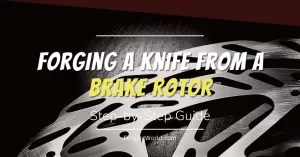Everyone who is getting started with knifemaking understands the importance of using a good piece of steel to make a knife out of. You can use whatever you find at a scrap yard or in your garage. Not every steel makes a good blade, period.
This is why I wrote this article, so after reading it you will know which steel is good and which you should throw away.
So, how do I know I have the right steel for knife making?
To know whether your steel is good for knifemaking, you should make a spark test, file test, and finally a break test. These 3 tests will give you an estimate of the carbon content and hardness level. After finishing all of them, you will grasp a general idea of whether you can use them or not.
Next, I will explain more about what makes good steel for knife making. That way you will have a better understanding of what you are looking for in the first place. After that, I will cover each test in great detail so you know exactly what to do.
Well, knifemakers, let’s get started.
What Makes a Good Steel for Knifemaking
Before we move on, I want to first clarify what steel is. Steel is a combination of iron, carbon, and other alloying elements. As you change different alloys, you change the working qualities of steel. This is also why steel can be used for various uses.
As I have already said, not every steel is good for knife making. Good knifemaking steel has enough carbon content, which plays a major role in the quality of the blade. If the steel is low-carbon, it won’t produce a good-quality blade. On the other side, if the steel has too much carbon, it will become more brittle.
For a typical knife, you want steel that is high in hardness, strength, toughness, edge retention, workability, sharpness, and preferably corrosion resistance. Generally, you don’t want steel with less than 0.6% of carbon.
Chances are it won’t hold the edges very well and will dull quickly. Note that not all knives are made for the same purpose. For example, some knives require more toughness and edge retention than others. So, according to the type of knife, you will choose the convenient steel.
Another important factor in choosing the right steel is whether you use the forging technique or stock removal. Knifemakers who forge their knives will typically use 10x series sheets of steel. These are simple carbon steels with a carbon content usually between 0.5 and 1% which is ideal for the heat-treating process. When it comes to stock removal, knifemakers who do this technique tend to use stainless steel.
Since people will usually test scrap steel I will put a greater emphasis on them. Things like suspension springs, leaf springs, rebars, circular saw blades, railroad spikes, and steel files are some of the most common scrap steels used for knifemaking purposes.
After years of experience and working with scrap steels I have managed to nearly identify what steels are these scrap steel usually made from. Check the table below.
| Item | Steel |
| Axels | 1040 |
| Clutch springs | 1070 |
| Coil springs, truck | 5160 |
| Cold-rolled steel | 1070 |
| Crankshafts | 1045 |
| Drifts | L6, S2, S7 |
| Files | W2, 1095 |
| Harrow disk | 1080 |
| Leaf springs | 1085, 5160 |
| Nail sets | L6 |
| Screwdrivers | L6, S2 |
| Spring clips | 1060 |
| Spring steel, clock | 1095 |
| Transmission shafts | 4140 |
| Wrenches | L6, S2 |
The Spark Test
The first and also the most popular test for determining the quality of steel is the Spark test. This is a simple and fast way of determining the potential carbon content in particular steel. The good news is that the Spark test doesn’t require any special or expensive equipment. All you need is some kind of grinder. I personally recommend a bench grinder because it is much easier to control the steel and get a good stream of sparks.
When put on a grinding wheel, steel produces flying sparks where each kind of steel produces a different volume and color. In the past, this test was one of the quickest and most accurate ways of determining the type of steel at home. But in today’s world, there are hundreds of different alloy combinations which makes the Spark test more difficult.
Note that even the manufacturer changes the type of steel which makes things even more complicated. So, you could easily say that the Spark test is not accurate as it once was, but it can still be used to get a good classification.
The Spark test is only useful if you understand what you are looking for. With that in mind, you should observe the number and color of sparks. The number of springs is proportional to the carbon content. The more bursts at the end of the sparks, the more carbon that steel has. If the steel produces no sparks, that means that the metal is non-ferrous. For instance, wrought iron produces very few sparks due to its low carbon content. Unlike wrought iron, high-carbon steel produces a lot of sparks.
In terms of color, it helps to identify the alloy content. For instance, if the material produces white sparks it means titanium or manganese. On the other hand, nickel, cobalt, and chromium produce dark red sparks.
Keep in mind that the identification of the sparks may require some experience. I see many beginners online saying they don’t see any difference between scrap metal. While that can be due to low experience, I would recommend setting your working place darker. That way you will be much more able to distinguish the differences.
Before you start with testing, I recommend checking through the following safety precautions:
- Make sure that the grinder is properly installed
- Stay on the side of the grinder when working
- Wear a face shield or at least safety glasses
- Keep your fingers away from the grinder
Ok, the first thing you have to do is to find some type of grinder. The general recommendation is to use a bench grinder. It is better to hold the steel rather than a grinder because you can get a better stream of sparks. Keep in mind that the grinding wheel should have a speed of at least 23 m/s (4500 surface feet per minute). However, the recommended speed is somewhere between 38-58 m/s (7500-11,500 sfpm). Again, the workshop should be set dark so you can correctly observe the sparks.
After that, turn it on and apply the metal to the grinder. Just be careful not to put too much pressure as that will increase the temperature of the spark which will further give the wrong results. Namely, higher pressure produces more sparks. This can make you think you have high-carbon steel whereas, in reality, you don’t. So, keep in mind to always apply the same amount of pressure.
Low carbon steel sparks are very similar to wrought irons, except they have small forks and the length varies much more. The sparks are white. The usual example is mild steel.
High-carbon steel produces a bushy spark pattern that begins at the grinding wheel. Note that the sparks are not as bright as the medium carbon steel.
Stainless steel produces bright yellow streaks with a small leaf.
Wrought iron produces sparks that flow out in straight lines. The tails of the sparks widen out near the end, very similar to a leaf.
The File Test
The File test is an excellent way to provide with you an idea of relative hardness. To successfully do this test, you must first heat the piece of metal and quench it. Heat the piece until it reaches non-magnetic temperatures and after that immediately quench it in either water or oil. Note that you only need a small piece of metal for this, you don’t have to spend a lot of material.
To perform this test correctly all you need is a file, a piece of metal, and a vice. First, clamp your working piece in the vise. Next, take the file and make 3-5 strokes on the edge of your material. You can do that in several different places. The key thing is to observe the amount of bite because it indicates carbon content. Make sure you do only forward strokes.
For instance, if the file easily bites in, this is usually an indication of mild steel and therefore should not be used for knife making. The file will produce a dull tone in this case. On the contrary, if the file skates over the surface, it means that the metal is hard and likely high-carbon steel.
I would highly recommend having a TTC 6 Piece Hardness Tester File Set. This is by far the best way of doing this test as you can specifically see in what hardness level your metal is. In this set, you have files ranging from 40-65 HRC. I have had this set for a few years and could not be happier.
As with other tests, consistency is crucial for achieving proper results. Keep in mind that hardness is only an indicator of carbon content. To have an even better understanding of your mysterious steel, you have to do the following test.
The Break Test
This is the final test we will give you to grasp the understanding of the metal you plan to use for knifemaking purposes. If you still have doubts about whether it is high-carbon steel or not, don’t worry, this one would do the trick. This test can be performed without forging for thing objects.
However, I recommend forging it first. Simply heat to above non-magnetic and quench it in water. That way it will achieve the full possible hardness as opposed to quenching it in oil. After heat-treating, tightly clamp the metal in a vise. Now, simply take a hammer and strike it.
If the metal snaps off without any bending, you can be almost sure it is high-carbon steel. If it bends without breaking, it is probably low-carbon steel. Finally. If it breaks after a couple of strikes it is likely somewhere in between. The first scenario is ideal for knife making because only the steel that breaks cleanly will be hard enough to make a good knife.



